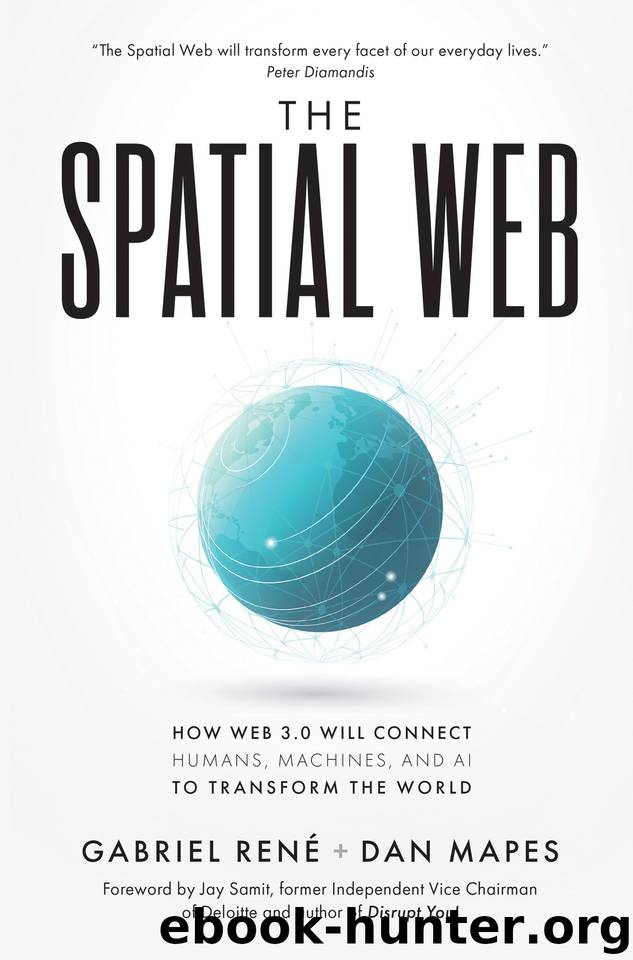The Spatial Web: How Web 3.0 Will Connect Humans, Machines, and AI to Transform the World by Mapes Dan & René Gabriel

Author:Mapes, Dan & René, Gabriel [Mapes, Dan]
Language: eng
Format: epub
Publisher: Gabriel René and Dan Mapes
Published: 2019-08-25T16:00:00+00:00
SPATIAL PROTOCOL
A UNIVERSAL SPATIAL PROTOCOL STANDARD
W eb addresses designed for interactions with text, media, and the navigation of web pages are not a sufficient technological foundation with which to develop the next generation of spatial applications and web spaces for people and things to interact, transact with, and navigate between. It isn’t designed to integrate the disparate technologies of the Web 3.0 era—AR, VR, AI, IoT, and DLTs. For this, we need to establish a new spatial protocol standard—one that communicates to and through each tier of the Web 3.0 stack. A spatial world needs a Spatial Protocol. It is the digital thread from which the Spatial Web is woven.
The Spatial Protocol can take into account the features, properties, and requirements of each tier of the stack, as well as effects generated by the entire stack working together. It is what enables Web 3.0 to be spatial, cognitive, physical, decentralized, and secure simultaneously, weaving each layer of the stack into a strong and contiguous digital fabric.
HyperSpace Transaction Protocol
The web is currently accessed by the protocol HTTP (HyperText Transfer Protocol) to route users and content between web pages. Similarly, HSTP (HyperSpace Transaction Protocol) will route users and 3D content such as objects/assets between web spaces.
The Spatial Protocol is not merely another disruptive technology but a foundational one, designed to serve as the digital infrastructure to support the next generation of Web 3.0 applications. Foundational technologies facilitate disruption across every industry. They enable users, objects (virtual or physical), and information to interact and transact together within and across any virtual or physical space, allowing these spaces to be networked together so that users, objects, and information can seamlessly move between them, like the Web. But unlike our current Web—a network of informational web pages locked behind a screen—a Spatial Protocol weaves a web for the world we live and operate in, a network of experiential web spaces—the Spatial Web.
HSTP is the solution for traversing the Spatial Web. Users and Smart Assets can be transferred or relocated between Spatial Domains anywhere across the Spatial Web, using HSTP for “hyperporting” between web spaces by allowing “hyperspace” links to be placed in one webspace that links to any information about anything or to another webspace. This is similar to how we link content and web pages on the Web today.
With an address for every space and a protocol to connect these spaces, we can move objects from space to space securely, we can track movements through space, and we can automate transactions through space.
Download
This site does not store any files on its server. We only index and link to content provided by other sites. Please contact the content providers to delete copyright contents if any and email us, we'll remove relevant links or contents immediately.
| AI & Machine Learning | Bioinformatics |
| Computer Simulation | Cybernetics |
| Human-Computer Interaction | Information Theory |
| Robotics | Systems Analysis & Design |
Algorithms of the Intelligent Web by Haralambos Marmanis;Dmitry Babenko(16235)
Jquery UI in Action : Master the concepts Of Jquery UI: A Step By Step Approach by ANMOL GOYAL(9387)
Test-Driven Development with Java by Alan Mellor(7735)
Data Augmentation with Python by Duc Haba(7609)
Principles of Data Fabric by Sonia Mezzetta(7378)
Learn Blender Simulations the Right Way by Stephen Pearson(7294)
Microservices with Spring Boot 3 and Spring Cloud by Magnus Larsson(7137)
Hadoop in Practice by Alex Holmes(6587)
RPA Solution Architect's Handbook by Sachin Sahgal(6516)
The Infinite Retina by Robert Scoble Irena Cronin(6216)
Big Data Analysis with Python by Ivan Marin(5934)
Life 3.0: Being Human in the Age of Artificial Intelligence by Tegmark Max(5516)
Pretrain Vision and Large Language Models in Python by Emily Webber(4894)
Infrastructure as Code for Beginners by Russ McKendrick(4653)
Functional Programming in JavaScript by Mantyla Dan(4436)
WordPress Plugin Development Cookbook by Yannick Lefebvre(4382)
The Age of Surveillance Capitalism by Shoshana Zuboff(4245)
Embracing Microservices Design by Ovais Mehboob Ahmed Khan Nabil Siddiqui and Timothy Oleson(4148)
Applied Machine Learning for Healthcare and Life Sciences Using AWS by Ujjwal Ratan(4135)
